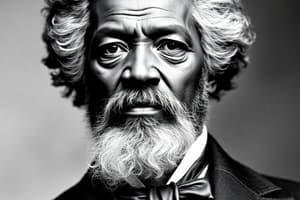Podcast
Questions and Answers
How did the admission of Arkansas and Michigan as states affect the balance between slavery and freedom?
How did the admission of Arkansas and Michigan as states affect the balance between slavery and freedom?
It maintained the balance by adding one slave state and one free state.
What were the implications of the Fugitive Slave Act on the growing antislavery movement?
What were the implications of the Fugitive Slave Act on the growing antislavery movement?
The Fugitive Slave Act intensified the controversy surrounding slavery and galvanized antislavery advocates.
What unique circumstances allowed Frederick Douglass to learn how to read and write?
What unique circumstances allowed Frederick Douglass to learn how to read and write?
He received unique privileges from his upbringing and demonstrated exceptional determination.
What was the outcome of the Missouri Compromise of 1820 and its significance?
What was the outcome of the Missouri Compromise of 1820 and its significance?
Which amendments were debated concerning slavery and how did they impact discussions on its future?
Which amendments were debated concerning slavery and how did they impact discussions on its future?
How did the annexation of Texas and Florida contribute to the sectional crisis?
How did the annexation of Texas and Florida contribute to the sectional crisis?
What were Ohio's Black Laws of 1803 and their effects on African Americans?
What were Ohio's Black Laws of 1803 and their effects on African Americans?
In what way did pro-slavery arguments reference the Constitution to legitimize slavery?
In what way did pro-slavery arguments reference the Constitution to legitimize slavery?
Flashcards
Missouri Compromise of 1820
Missouri Compromise of 1820
A compromise that admitted Missouri as a slave state and Maine as a free state, preserving the balance between slave and free states in the Senate.
3/5ths Compromise
3/5ths Compromise
Slaves were counted as three-fifths of a person for the purpose of representation in Congress.
Fugitive Slave Act
Fugitive Slave Act
A federal law requiring the return of runaway enslaved people to their owners.
Frederick Douglass
Frederick Douglass
Signup and view all the flashcards
Texas Annexation (1845)
Texas Annexation (1845)
Signup and view all the flashcards
Antislavery Arguments
Antislavery Arguments
Signup and view all the flashcards
Pro-slavery Arguments
Pro-slavery Arguments
Signup and view all the flashcards
Ohio's Black Laws
Ohio's Black Laws
Signup and view all the flashcards
Study Notes
State Admission and Sectional Crisis
- Arkansas (slave) and Michigan (free) states' admission maintained the slavery/freedom balance.
- Texas and Florida's annexation in 1845 worsened sectional tensions.
- Texas's admission in 1845 was secured by President Sam Houston's deal with Polk.
- Florida was admitted as a slave state in 1845.
- The Fugitive Slave Act and antislavery voices (like Frederick Douglass) intensified the debate.
Frederick Douglass's Life and Influence
- Born into slavery in 1818 in Maryland, Douglass had limited knowledge of his birthdate and mother.
- Through unique opportunities and determination, he learned to read and write.
- Escaped slavery in 1837 at age 19.
- Published his autobiography Narrative of the Life of Frederick Douglass in 1845, launching his advocacy for the enslaved.
- His work heightened awareness of Black politics.
Pro- and Anti-Slavery Constitutional Arguments
- Pro-Slavery:
- Article 1, Section 2: Allowed slaves to be counted as 3/5ths of a person for elections.
- Congress couldn't interfere with the slave trade before 1808.
- Congress had the authority to make fugitive slave laws.
- Anti-Slavery:
- Framers hoped slavery would eventually end.
- Constitution ended the slave trade by 1808.
- The 10th Amendment allowed banning slavery in territories.
- The 5th Amendment allowed seizing "property" through legislation.
Missouri Compromise and Regional Divisions
- The 1820 Missouri Compromise admitted Missouri (slave) and Maine (free) states, highlighting the precarious free/slave state balance in the Senate.
- Exposed deep divisions regarding slavery & the Constitution's intent on expansion.
- The Ohio River Valley became a key conflict zone.
- Kentucky and Tennessee became slave states while Ohio, Indiana (1816), and Illinois (1818) joined as free states.
- "Black Laws" in Ohio (1803) severely restricted Black people, preventing voting, education, jury service, and militia participation.
Studying That Suits You
Use AI to generate personalized quizzes and flashcards to suit your learning preferences.




